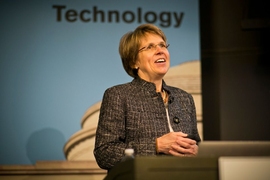How do plants bring the Earth to life? How does the sun move water around the Earth?
These are seemingly elementary questions, but many people — young and old — struggle to answer them. As a professor of 7.014 (Introductory Biology) for undergraduate students at MIT, Institute Professor Sallie (Penny) Chisholm recognizes that photosynthesis and other natural processes don’t sink in for a lot of people. In response, Chisholm partnered with her longtime friend, award winning children’s book author and illustrator Molly Bang, to write a series of children’s books explaining these fundamental environmental processes in an approachable way.
The pair has since created the “Sunlight Series,” a collection of children’s books written about different environmental topics from the point of view of the sun. The latest in the series, “Rivers of Sunlight: How the Sun Moves Water around the Earth,” explains the global water cycle.
At first, the Sunlight Series wasn’t written with a specific audience in mind; it was just to make this critical information available in an easy-to-understand way. “This is fundamental information about how the Earth works that nobody understands, even educated people who have taken classes on these topics. They don’t remember it because it’s too weird to think of plants and life coming from the air and from the sun,” Chisholm said.
The series is meant to stand the test of time by explaining fundamental processes, but that doesn’t stop Chisholm and Bang from briefly acknowledging humans' uncertain impact on the environment by touching on topics such as climate change and fossil fuels. Chisholm asks, “If you don’t understand that the mass of plants come from carbon dioxide in the atmosphere, and that there’s a massive exchange of CO2, from photosynthesis and respiration, how can you understand the role of fossil fuels and climate change?”
From scientist to children’s book author
The first page of “Living Sunlight: How Plants Bring the Earth to Life,” the first book by Chisholm and Bang, asks readers to “Lay your hand over your heart, and feel. Feel your heart pump, pump, and pump. Feel how warm you are. That is my light, alive inside of you.” Chisholm recalls one of her adult friends reading this part of the book and thinking that it was a metaphor, so Chisholm explained to her that solar energy is literally the energy that keeps bodies warm. The food we eat has its origins in photosynthesis, so the chemical energy in the food comes from the sun. We metabolize that food to keep our bodies warm.
“Even after reading the book it didn’t sink in for her, and then when it sunk in she had this huge epiphany. That was really rewarding to me, because that’s really what we’re trying to get at, that everything is connected,” Chisholm said.
Despite being labeled children’s books, the Sunlight Series appeals to all age groups. The illustrations, hand-painted by Bang, are colorful and animated, but are also structurally and anatomically correct. On one page from “Living Sunlight,” Chisholm jokes that there are “glucose in the sky with diamonds,” referring to the Beatles’ hit song, “Lucy in the Sky with Diamonds,” since there are sparkling glucose molecules embedded into the design of the horizon. The latest book, “Rivers of Sunlight,” also features water molecules pulled out of grand ocean artwork. Bang’s parents were scientists, and she learns the science behind the illustrations from Chisholm. It also furthers the educational motivation behind the series. A 7th grade student who read Chisholm and Bang’s books told Chisholm that the series made topics he had read about in school more accessible and easier to comprehend with the pictures.
Chisholm acknowledges that she cannot be too detailed and scientific in the books, since they are simplified for young readers. To compensate, each book ends with notes that dive deeper into the complex topics and processes that are mentioned in each story.
Finding inspiration in famous research
Chisholm, who has been at MIT since 1976, is currently an Institute Professor in the departments of Civil and Environmental Engineering and Biology. She is most well-known for her role in discovering Prochlorococcus, the smallest and most abundant photosynthetic organisms on Earth. They form the base of the ocean food web and produce a significant amount of oxygen in the ocean. Prochlorococcus are small phytoplankton, essentially little plants in the ocean that are able to photosynthesize, like plants on land. Prochlorococcus are too specific for the elementary reading level of the Sunlight Series, but phytoplankton are introduced in “Ocean Sunlight,” Bang and Chisholm’s second book, and the careful reader can find them in the illustrations.
In 2013, Chisholm was awarded the National Medal of Science by President Barack Obama for her research. To balance teaching, conducting research, and writing books, Chisholm typically works a lot on the Sunlight Series over the summer, the time of year when Bang also resides in Massachusetts. “Everything I do is a lot of work, but it goes in spurts,” Chisholm said. She and Bang had been brainstorming a book topic for about a decade before publishing “Living Sunlight” in 2009.
The Sunlight Series provides an overview of Earth’s natural processes, giving a simplified explanation in layman’s terms in a short amount of pages. Chisholm says that the simplicity of Prochlorococcus, due to its small amount of information, essentially inspired the Sunlight Series in this way. While the series gives a brief overview of natural processes, Chisholm describes Prochlorococcus as similarly having the smallest amount of information in its genome that is able to make life out of solar energy and inorganic compounds.
Bang and Chisholm tell the story of the Earth through the point of view of the sun, just as Chisholm’s research tells the story of Prochlorococcus. She says that Prochlorococcus keeps her inspired in her field. “It has so many stories to tell. It’s floating around out there in the oceans and it has been evolving for eons. Every genome that we sequence, every strain that we isolate, every other strain that we put it together with, they have conversations. I think about it as something that is trying to tell us its stories.”










